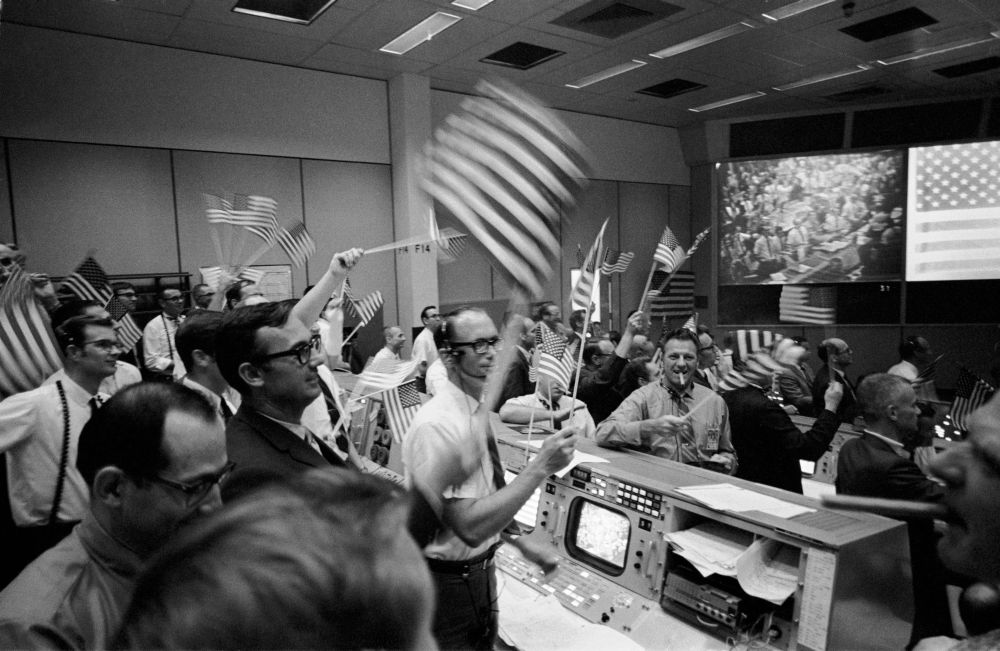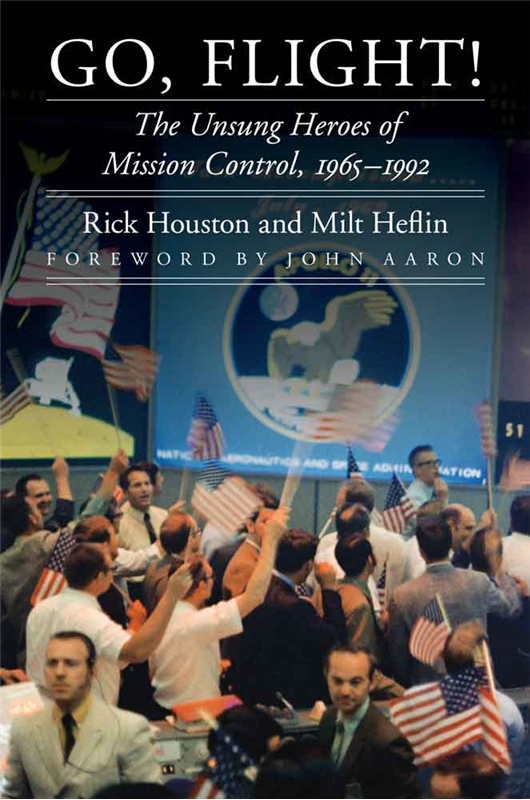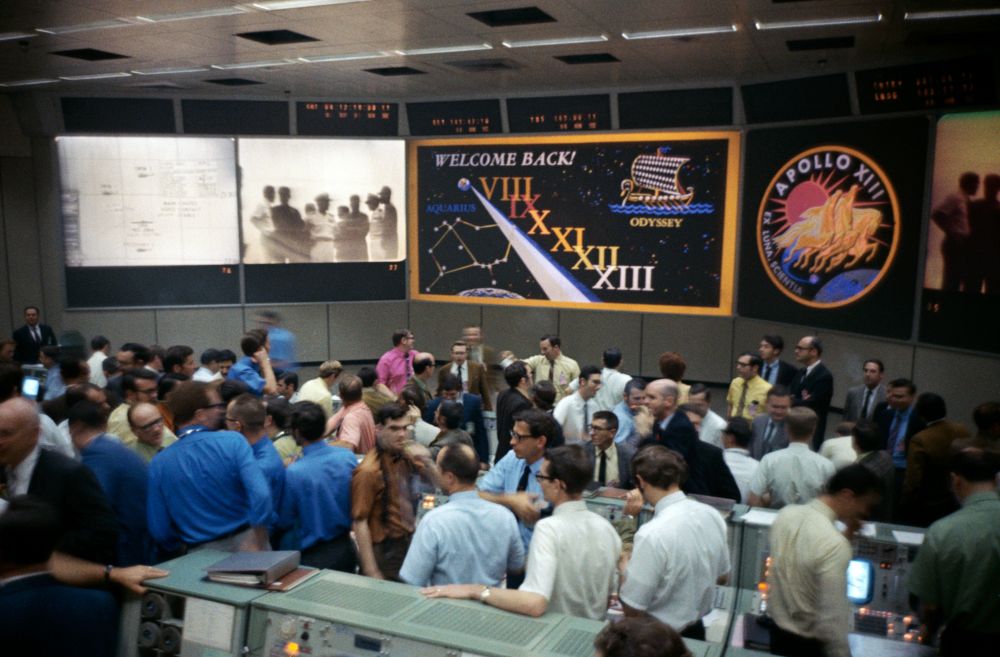
The stories of astronauts’ accomplishments—especially during the Apollo era, which saw humans land and walk on another world for the first (and hopefully not last) time—have been recounted many times in spaceflight history. However, a recently-published University of Nebraska Press book (another in the Outward Odyssey spaceflight series) tells the incredible stories of those who saw history unfold on the ground. Go, Flight!: The Unsung Heroes of Mission Control, 1965 – 1992, written by Rick Houston and Milt Heflin (himself a former flight director), discusses the diverse personalities who helped to often save missions from terra firma.
Houston, who also authored Wheels Stop: The Tragedies and Triumphs of the Space Shuttle Program, 1986 – 2011, conducted extensive interviews with key figures who graced Houston, Texas’ MOCR (Mission Operations Control Room) during Gemini, Apollo, and beyond, gaining insight into the men (and later, women) whose decisions were sometimes the difference between life and death for crews, especially during 1970’s troubled Apollo 13. Similar to their astronaut counterparts in space, often the flight controllers’ achievements came at a tremendous personal cost. AmericaSpace recently talked to Houston, who recounted how these figures’ contributions were vital to the “Golden Era” of spaceflight.
AmericaSpace: Go, Flight! discusses the diverse, lesser-known personalities in NASA’s Mission Control during its “Golden Years” (arguably the Apollo era). Much has been discussed already concerning legendary figures such as Gene Kranz (played by actor Ed Harris in the blockbuster Apollo 13 movie) and Chris Kraft. Why was it important for you and Heflin (also a flight director) to profile the lives and achievements of these men (and later, women)?

Rick Houston: For me, there were actually several reasons. The first of those was that these folks helped land men on the surface of the Moon, yet they remained virtually unknown to the general public. They deserve the recognition.
The second major reason developed over the course of researching and interviewing these extraordinary people. Some of them had very strong personalities. Some of them were as quiet as church mice. And between the two, they sometimes had quite serious disagreements over mission rules, and so forth. But for the good of the team and accomplishing the goal set before them, they set those disagreements aside. There is an almost startling lesson in that for today’s me-first-at-all-costs generation.
AmericaSpace: Go, Flight! often delves into the lives of figures including John Llewellyn, who excelled in his role in Mission Control despite suffering from what is now known as severe PTSD (due to the Korean War), child of immigrants Bill Moon who was one of the first “minorities” in the MOCR, and Ed Fendell, whose career trajectory wasn’t typical (he did not possess an engineering degree). In addition, later pioneers like Marianne Dyson, one of the first women controllers, were also profiled. Which of the controllers had stories that impacted you the most during your interviewing/research phase, and why?
Houston: A better way to put it might be which of the controllers didn’t have a story that impacted me? The answer would be none of them.
You mentioned John Llewellyn. The biggest regret in doing this book was that I did not get to interview him, because he very sadly passed away at about the same time as the idea was first beginning to take shape. How he overcame the things he’d seen and done in Korea is beyond me.
I’m truly in awe of Ed Fendell, who had a personality every bit as strong as Llewellyn’s. It wasn’t that Ed didn’t possess an engineering degree … to this day, he does not have a four-year degree of any sort. He has just a two-year associate’s degree in merchandising of all things. That he came to be in charge of Apollo communications is a feat that simply leaves me in awe.
Another stunning story is Bill Moon’s. Mississippi wasn’t exactly a beacon of racial acceptance in the 1950s; this son of Chinese immigrants was not only accepted in high school, but was also a founding member of a social fraternity in college. One of the best stories I heard Bill tell was about the time Jim Lovell hugged him, and said it was the closest he’d ever get to a Moon.
AmericaSpace: We’ve all heard about the heroics surrounding Apollo 13, and, of course, the intense efforts to return the crew home alive and safe is covered in detail in Go, Flight! However, the book also covers lesser-known flight incidents, including Gene Cernan’s harrowing Gemini 9A spacewalk, the Apollo 6 launch issues, Apollo 14’s docking problems, and more. Whose reaction to an unexpected event or crisis stuck out to you the most, and what made the controllers’ reactions to these problems unique?
Houston: The very best reaction of a single flight controller to a crisis was John Aaron’s famous SCE to AUX call during the launch of Apollo 12. If it had been me, I’d still be sitting there trying to figure out what to do. That he diagnosed the problem and came up with a remedy within seconds is astounding.
Apollo 13 is the greatest example of teamwork in NASA’s history. There was a certain amount of rivalry between the trajectory guys in the Trench and the systems guys up on the second row, but none of those came into play during 13. It wouldn’t have mattered in the least how good trajectory was if the systems folks hadn’t stretched their consumables to the nth degree. The same was true in reverse. If they’d had all the water and electricity in the world, it wouldn’t have mattered if Odyssey bounced off the atmosphere because the trajectory was too shallow, or burnt up reentering because it was too steep.

AmericaSpace: While the flight controllers were hard-wired to deal with crises, they also were able to savor the successes of flights, especially Apollo 8 and Apollo 11. However, it can be argued some of the controllers sacrificed their personal lives for their careers. Would you say the controllers thought it “was all worth it” despite the stresses and the sacrifices?
Houston: It’s interesting you ask that question, because if you asked it of [controller] Bob Carlton, he would insist that it was not worth the sacrifice of family time. Bob was evidently a pretty hard charger back then, and I had to laugh when his daughter talked of her friends calling and her dad answering the phone by barking, “Go!” Bob insists that he was away from home too much, and that it cost his family life dearly. However, both of his daughters also insist just as firmly that he was as good a father as he could have possibly been, and that they now understand why he did what he did.
AmericaSpace: Sadly, figures such as Kranz and Jay Greene had a first-row seat to the 1986 Challenger tragedy. While the public saw the disaster happen on live TV, the controllers didn’t seem to have any urgent warning about what was about to take place, making it all the more devastating. Was there anything notable about how these men and women dealt with tragedy (not altogether unexpected in something as risky as spaceflight)?
Houston: I think they grieved for the people who were lost and their families, but they also had a job to do. That was the case for the Apollo 1 fire, as well as Challenger and Columbia. Each understood full well that spaceflight was a risky business, but certainly, I think Challenger especially woke people up to the fact that something like that could happen on their watch. Apollo 13 probably created this impression among a lot of people that NASA could handle any crisis … and that just wasn’t the case.
AmericaSpace: Lastly, the lessons of “vintage” Mission Control can still be felt today, as we segue into the Orion era and continue ISS operations. We’ve all heard of heroics of various astronauts throughout the decades. Which qualities and values in Mission Control today can be traced to the earliest days of spaceflight, and what makes these pioneers heroic?
Houston: The biggest and most important characteristic is an unswerving dedication to excellence. There was no such thing as “close enough for government work” in Mission Control. John Aaron’s SCE to AUX call was the result of a lesson he’d learned a year before the Apollo 12 launch, and he’d gone to the lengths of studying the issue … just in case.
There was no textbook on how to work in Mission Control back in the 1960s, because they were writing it as they went. Dutch von Ehrenfried taught Ed Fendell how to read a schematic by having him color various parts with crayons. Bob Carlton had his guys drawing schematics until their hands all but fell off. One of the very best memories I have of this entire process is sitting in the MOCR with Bob Carlton, and watching him draw a detailed diagram of the Lunar Module’s descent engine … and the guy was 80-some-odd years old and still had perfect recall. I hope I’m that sharp when I’m fifty.
But that’s the kind of dedication they had. They knew their areas of responsibility up and down, right to left, backward and forward. And if they didn’t know a detail … their backups in the Staff Support Room did.
*****
Many thanks to Rick Houston for his participation. For more information about the book, please visit Go, Flight’s Facebook page.
Want to keep up-to-date with all things space? Be sure to “Like” AmericaSpace on Facebook and follow us on Twitter: @AmericaSpace
Missions » Apollo »



One Comment
One Ping
Pingback:The Other Side of Spaceflight: An Interview With Rick Houston, Co-Author of ‘Go, Flight!’ | On Reddit